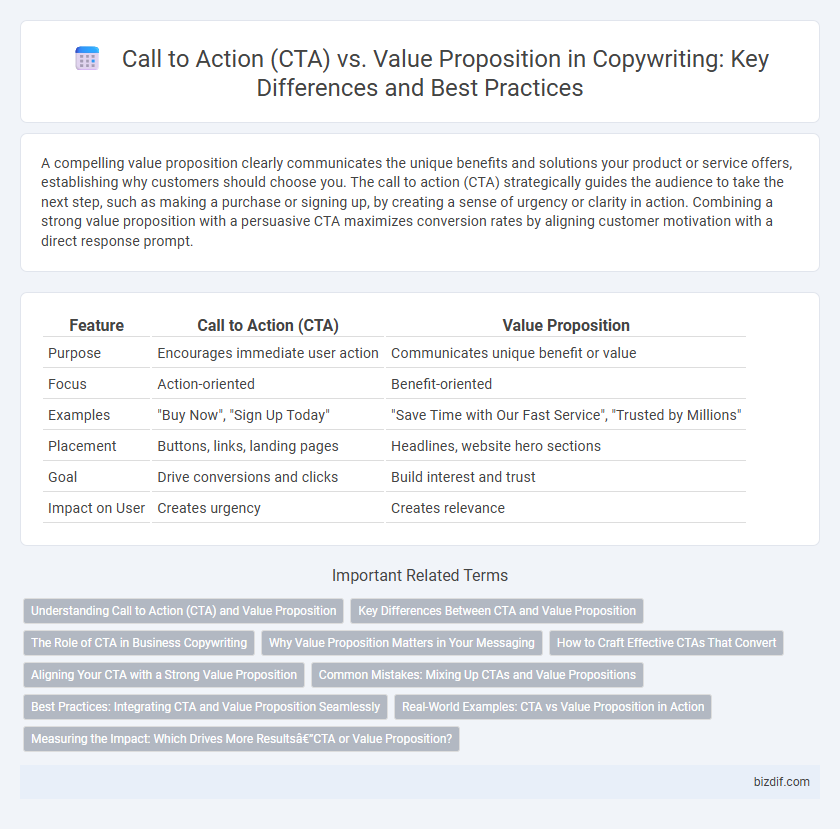A compelling value proposition clearly communicates the unique benefits and solutions your product or service offers, establishing why customers should choose you. The call to action (CTA) strategically guides the audience to take the next step, such as making a purchase or signing up, by creating a sense of urgency or clarity in action. Combining a strong value proposition with a persuasive CTA maximizes conversion rates by aligning customer motivation with a direct response prompt.
Table of Comparison
| Feature | Call to Action (CTA) | Value Proposition |
|---|---|---|
| Purpose | Encourages immediate user action | Communicates unique benefit or value |
| Focus | Action-oriented | Benefit-oriented |
| Examples | "Buy Now", "Sign Up Today" | "Save Time with Our Fast Service", "Trusted by Millions" |
| Placement | Buttons, links, landing pages | Headlines, website hero sections |
| Goal | Drive conversions and clicks | Build interest and trust |
| Impact on User | Creates urgency | Creates relevance |
Understanding Call to Action (CTA) and Value Proposition
A Call to Action (CTA) directs users to take a specific step, such as "Buy Now" or "Subscribe Today," driving immediate engagement and conversions. A Value Proposition clearly communicates the unique benefits and value a product or service offers, differentiating it from competitors and building trust. Understanding the distinction enhances copywriting effectiveness by combining compelling benefits with actionable prompts that motivate user response.
Key Differences Between CTA and Value Proposition
A Call to Action (CTA) directs users to take a specific step, such as "Buy Now" or "Subscribe Today," serving as a prompt for immediate engagement. In contrast, a Value Proposition communicates the unique benefits and core promises of a product or service, explaining why it's valuable and differentiating it from competitors. The key difference lies in the CTA's focus on encouraging action, while the Value Proposition centers on building trust and highlighting value.
The Role of CTA in Business Copywriting
A Call to Action (CTA) serves as a critical prompt that drives audience engagement and conversion rates by encouraging immediate responses such as signing up, purchasing, or contacting a business. Unlike the value proposition, which communicates the unique benefits and reasons to choose a product or service, the CTA is focused on clear, actionable steps that guide prospects through the sales funnel. Effective CTAs boost click-through rates and foster customer interaction, making them indispensable elements in business copywriting strategies.
Why Value Proposition Matters in Your Messaging
A strong value proposition clearly communicates the unique benefits and solutions your product or service offers, making your messaging more persuasive and relevant to your audience. Unlike a call to action that simply urges immediate response, a well-crafted value proposition establishes trust and addresses customer needs upfront. Prioritizing your value proposition enhances engagement, improves conversion rates, and differentiates your brand in competitive markets.
How to Craft Effective CTAs That Convert
Effective CTAs that convert clearly communicate the immediate benefit and create urgency, encouraging users to take specific actions like "Download Now" or "Get Your Free Trial." Integrating the value proposition into the CTA amplifies its appeal by highlighting unique benefits or solutions tailored to the target audience's needs. Testing different CTA phrases, button colors, and placements provides data-driven insights to optimize conversion rates and enhance user engagement.
Aligning Your CTA with a Strong Value Proposition
Aligning your Call to Action (CTA) with a strong value proposition increases conversion rates by clearly communicating the unique benefits your offer provides. A compelling value proposition establishes relevance and trust, motivating users to take the desired action through a specific, outcome-driven CTA. This strategic alignment ensures both elements work together seamlessly to drive user engagement and boost sales.
Common Mistakes: Mixing Up CTAs and Value Propositions
Confusing Call to Action (CTA) with Value Proposition weakens marketing effectiveness by diluting the message's clarity and persuasive power. A Value Proposition defines the unique benefits and reasons to choose a product, while a CTA prompts immediate user action, such as "Buy Now" or "Sign Up." Mixing these elements often leads to vague communication, reducing conversion rates and customer engagement.
Best Practices: Integrating CTA and Value Proposition Seamlessly
Integrating Call to Action (CTA) and value proposition seamlessly involves clearly communicating the unique benefits while prompting immediate action, which increases conversion rates by aligning user intent with brand promises. Effective copywriting uses concise, benefit-driven language in the value proposition paired with action-oriented CTAs like "Get Started" or "Claim Your Offer" to create a compelling user journey. Testing different combinations of CTAs and value propositions through A/B split tests can optimize engagement and maximize ROI by revealing what resonates best with target audiences.
Real-World Examples: CTA vs Value Proposition in Action
Effective copywriting distinguishes between a clear Call to Action (CTA) and a compelling Value Proposition, as seen in campaigns like Apple's iPhone landing page where the Value Proposition emphasizes innovation and design, while the CTA prompts users to "Buy Now." Amazon's product pages highlight the Value Proposition through features and benefits, paired with a prominent "Add to Cart" CTA that drives immediate purchases. Successful marketing balances these elements by clarifying product value and guiding user behavior with actionable, goal-oriented language.
Measuring the Impact: Which Drives More Results—CTA or Value Proposition?
Measuring the impact of Call to Action (CTA) versus Value Proposition reveals that clear CTAs often drive immediate user engagement and higher conversion rates, while strong Value Propositions build long-term trust and brand loyalty. A/B testing data shows CTAs boost click-through rates by up to 20%, whereas compelling Value Propositions increase average session duration and repeat visits. Marketers must analyze metrics like conversion rate, bounce rate, and customer lifetime value to determine which element maximizes results for their specific campaign goals.
Call to Action (CTA) vs Value Proposition Infographic

 bizdif.com
bizdif.com